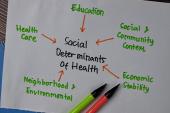For Angina Patients, Language Barriers Can Complicate CVD Care
People with chest pain and limited English proficiency are less likely than fluent speakers to report having a CVD history.

Patients with limited English proficiency who have angina are less likely than fluent speakers to report having a history of CVD, according to observational data from the National Health and Nutrition Examination Survey (NHANES).
This disconnect could indicate that people with a language barrier have CVD that flies under the radar and is undiagnosed, or they might have such diagnoses but be less informed about them, Brandon M. Herbert, MPH (University of Pittsburgh, PA), and colleagues reported recently in JAMA Network Open.
Herbert, whose research focuses on social determinants of health, told TCTMD their study was sparked by noticing “the gap in the literature regarding spoken language and cardiovascular disease awareness.”
There’s growing awareness that disparities in nonmedical factors like race, social isolation, poverty, economic instability, poor access to healthcare, and lower education can influence heart health, with additive effects.
One thing that came as a surprise in their analysis, said Herbert, is that several socioeconomic variables, such as education and income, weren’t significantly related to the likelihood of CVD reporting on multivariate analysis. He suggested this may be because these factors correlate so closely with English proficiency, making it “difficult to completely disentangle these effects given our modest sample size.”
Instead, the most likely culprit is “limited access to high-quality healthcare,” said Herbert, noting that it’s hard to identify the exact cause with the available data. He pointed out that 35% of patients with angina and lower English proficiency lacked health insurance, as compared with 13% of fluent English speakers. “However, it was interesting to see similar reported numbers of healthcare visits over the past year across [both] groups, which suggests a difference in quality or type of care may be present,” Herbert explained.
Approximately 9% of the US population—or nearly 30 million people—has limited English proficiency. “Federal regulations, such as Title VI of the Civil Rights Act, are in place to protect individuals with limited English proficiency from discrimination and receipt of substandard healthcare,” the researchers note, adding that evidence shows some hospitals don’t live up to that promise.
The number of people with limited English proficiency in the US “only continues to grow,” Herbert stressed. “This sizable and important subgroup of the population deserves much more attention in research focusing on cardiovascular disease prevention and treatment.”
Angina in NHANES
Herbert et al say NHANES presents a unique opportunity to study this issue, because the survey is administered both in English and Spanish, with interpreters provided for participants who speak other languages.
The researchers combined data from five cycles of NHANES (2007-2016) for all 19,320 adults 40 or older (mean age 57.8 years; 47.2% men) who took the Rose questionnaire, which assesses angina symptoms, during the survey. Those surveyed in English—82.6% of the cohort—were considered proficient.
Most participants were white (71.6%), followed by Black (10.6%), Mexican American (6.3%), other race (6.9%), and other Hispanic (4.6%).
Just 2.6% of the total population screened positive on Rose, and the likelihood of doing so was similar regardless of proficiency, as was the severity of angina. Ten percent overall reported having a history of CVD, defined as heart failure, coronary heart disease, angina, or MI. Patients with limited proficiency were less likely to report CVD than those with more-fluent English (7.3% vs 10.4%; P = 0.003).
Among the 583 participants who had angina on the Rose questionnaire, 96.1% were proficient in English, 62.1% were women, and 66.8% were white. Those with angina and limited English proficiency were less likely to report a history of CVD than those with better language skills (21% vs 39%; P = 0.002). In other words, fully 79% and 61% of those groups failed to report a history of CVD. Adjustment for potential confounders (age, sex, body mass index, diastolic blood pressure, and diabetes status) showed limited English nearly tripled the odds of not reporting CVD history (OR 2.77; 95% CI 1.38-5.55). Additionally, women with angina more often failed to report CVD compared with men (OR 2.63; 95% CI 1.57-4.40).
Communication Gaps
Regardless of fluency, self-reported CVD was far lower than what would be expected based on the angina questionnaire, the investigators observe. “This presents a major gap in care; many people have symptoms indicative of CVD but have not received a diagnosis.”
The findings highlight a need for better communication strategies targeted at patients with limited English proficiency that can further prevention and treatment, they say, suggesting there could be multiple reasons for the disparity in CVD reporting. Among them are the possibility that patients received a diagnosis but didn’t recall this information during the NHANES survey. CVD could be underdiagnosed among people with poor English skills, or it may be that those with limited proficiency are “overrepresented among those who remain outside of the healthcare system,” Herbert and colleagues note.
A patient with [limited proficiency] may simply ask very few questions during a visit, say only ‘yes’ to questions and comments, or provide inconsistent information to questions. Brandon M. Herbert
“Gaps in screening, diagnosis, communication regarding CVD, and access to services can all lead to poor outcomes. Healthcare institutions should identify systems-level barriers to care for patients who do not communicate in the dominant language,” they conclude. “By incorporating patient-centered practices, such as screening for and assessing risk for CVD in an individual’s preferred language, more patients may benefit from the equitable provision of guideline-directed therapies.”
Herbert said that clinicians also can take steps to address this need.
“First, it is critical for providers to identify patients with language barriers, and this may not be obvious. A patient with [limited proficiency] may simply ask very few questions during a visit, say only ‘yes’ to questions and comments, or provide inconsistent information to questions,” he said. One way to be sure, he suggested, is “to ask patients to repeat information that has been provided to them, and if they are not able to, to provide professional language services, if available.
“Additionally,” Herbert continued, “it is important for providers to consider a patient's ethno-cultural background as well when discussing and making healthcare decisions.”
Moving forward, the researchers hope to use improved diagnostic screening tools to get a better grasp of undiagnosed CVD among people with limited English proficiency, he said. Future research also will need to consider the effects of COVID-19, since the pandemic has likely exacerbated the disparity they found.
Caitlin E. Cox is News Editor of TCTMD and Associate Director, Editorial Content at the Cardiovascular Research Foundation. She produces the…
Read Full BioSources
Herbert BM, Johnson AE, Paasche-Orlow MK, et al. Disparities in reporting a history of cardiovascular disease among adults with limited English proficiency and angina. JAMA Netw Open. 2021;4(12):e2138780.
Disclosures
- Herbert reports no relevant conflicts of interest.





Comments